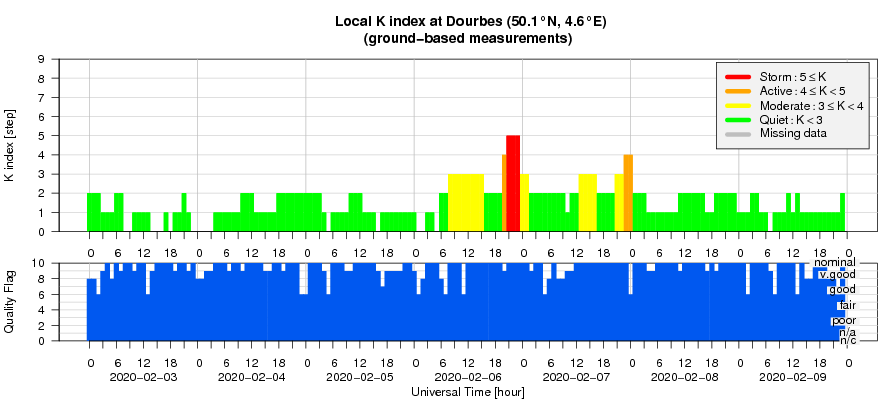- Table of Content
- 1.Solar Orbiter ...
- 2.Topical Issue ...
- 3.Review of sola...
- 4.PROBA2 Observa...
- 5.The Internatio...
- 6.Review of geom...
- 7.Geomagnetic Ob...
- 8.The SIDC space...
- 9.Review of iono...
2. Topical Issue "Space Weather Instrumentation" for JSWSC
3. Review of solar activity
4. PROBA2 Observations (3 Feb 2020 - 9 Feb 2020)
5. The International Sunspot Number by SILSO
6. Review of geomagnetic activity (3 Feb 2020 - 9 Feb 2020)
7. Geomagnetic Observations at Dourbes (3 Feb 2020 - 9 Feb 2020)
8. The SIDC space weather Briefing
9. Review of ionospheric activity (3 Feb 2020 - 9 Feb 2020)
Solar Orbiter and EUI: we have a mission.
The launch of Solar Orbiter from Cape Canaveral in Florida on February 9, 23:03 EST was successful.
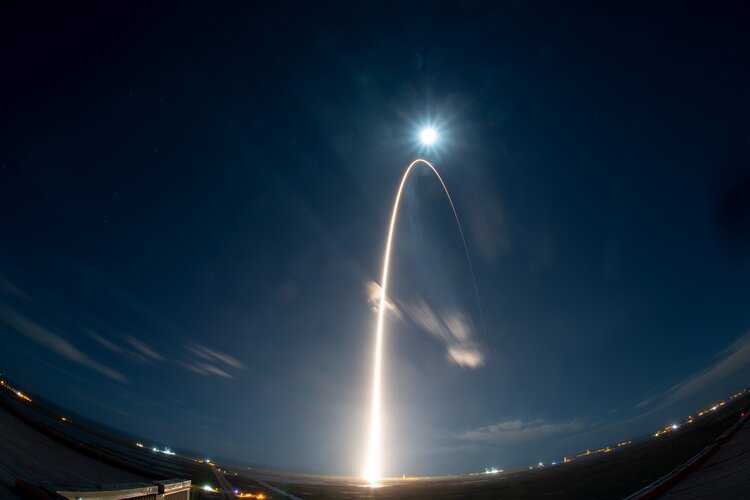
David Berghmans, PI : 'Solar Orbiter, with EUI on board, was launched this morning, 100% successful. The spacecraft was separated from the rocket, on an escape trajectory from the Earth, with solar panels deployed and communicating with the ground. We have a mission!'
Cis Verbeeck, EUI project manager at ROB, after a few hours of sleep after the launch: 'Solar Orbiter, EUI and years of work lifted of in a few minutes. It felt unreal. But we just woke up with a big smile.'
Emil Kraaikamp, writes software that processes raw telemetry from the EUI telescopes into images: 'That was an awesome show from Banana Creek. Very smooth launch, all on time, super weather nice clear skies with a full moon as bonus. I don't think anything can beat just looking at it and hearing it with your own eyes and ears directly. And I'm a bit too excited to go to sleep now.'
Check out this cool video that Emil made: https://www.youtube.com/watch?v=K-4TlaK3zJY
The second light ball is the moon.
Topical Issue "Space Weather Instrumentation" for JSWSC
The Journal of Space Weather and Space Climate (JSWSC - https://www.swsc-journal.org) has opened a new Topical Issue on "Space Weather Instrumentation" to appear in 2020/2021.
Space weather research, forecasting and operations rely on measurements and observations generated by specialized sensors and instrumentation. The purpose of this Topical Issue is to provide a forum dedicated to Space Weather Instrumentation questions and concepts. Topics to be covered include the following:
- Emerging requirements for Space Weather Instrumentation, data and resources;
- Ground-based Space Weather Instruments and networks (including magnetometers, VLF receivers, riometers, ionosondes and neutron monitors);
- Balloon and aircraft-based Space Weather Instruments;
- Space-based in-situ sensors measuring cause (particles and fields) and effect (internal / surface charging, solar cell degradation,...);
- Space-based remote-sensing instruments (EUV imagers, coronagraphs,...).
This Topical Issue arises from the 16th European Space Weather Week (ESWW16 - http://www.stce.be/esww2019/) held in Liège, Belgium, in November 2019, primarily from the Session 12 entitled "Space Weather Instrumentation". However, it is not restricted to papers presented during this session. All contributions related to these topics are welcome.
Questions regarding this topical issue are to be addressed to the topical editor-in-chief Richard A. Harrison (RAL Space, Rutherford Appleton Laboratory, UK). For questions concerning the submission process, please contact the Editorial Office (jswsc(at)edpsciences.org). Manuscripts must be submitted via the JSWSC online submission tool before the 31 May 2020 deadline. Guidelines for submission of papers are found on the JSWSC web site under the tab "Instructions for Authors"). If you need additional time to complete your submission, please do not hesitate to contact the JSWSC Editorial Office.
Topical Issue: Space Weather Instrumentation
Scope and guidelines: https://www.swsc-journal.org/news
The Topical Editor-in-Chief is Richard A. Harrison (Richard.harrison(at)stfc.ac.uk)
Deadline for submission: 31 May 2020
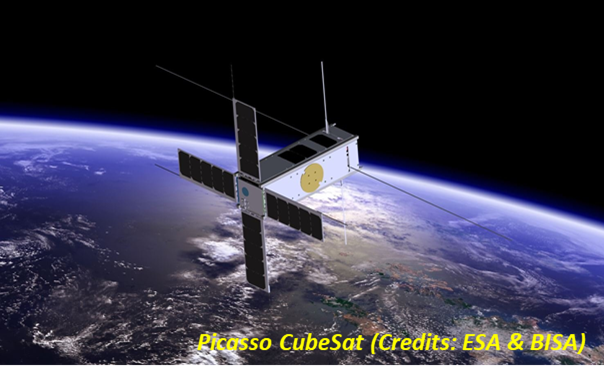
Review of solar activity
The Sun remained spotless with an X-ray flux below the B level.
No Earth directed CME's were observed.
A low latitude positive polarity coronal hole in the Northern hemisphere transited the central meridian on February 7.
The proton flux was at background levels. The high energy electron flux was enhanced near the end of the week. GOES measured this enhancement in the wake of the decaying high speed solar wind. It passed the event threshold on February 8 and 9.
PROBA2 Observations (3 Feb 2020 - 9 Feb 2020)
Solar Activity
Solar flare activity was very low during the week.
In order to view the activity of this week in more detail, we suggest to go to the following website from which all the daily (normal and difference) movies can be accessed: https://proba2.oma.be/ssa
This page also lists the recorded flaring events.
A weekly overview movie can be found here (SWAP week 515). http://proba2.oma.be/swap/data/mpg/movies/weekly_movies/weekly_movie_2020_02_03.mp4
Details about some of this week's events can be found further below.
If any of the linked movies are unavailable they can be found in the P2SC movie repository here
https://proba2.oma.be/swap/data/mpg/movies/
Monday Feb 07
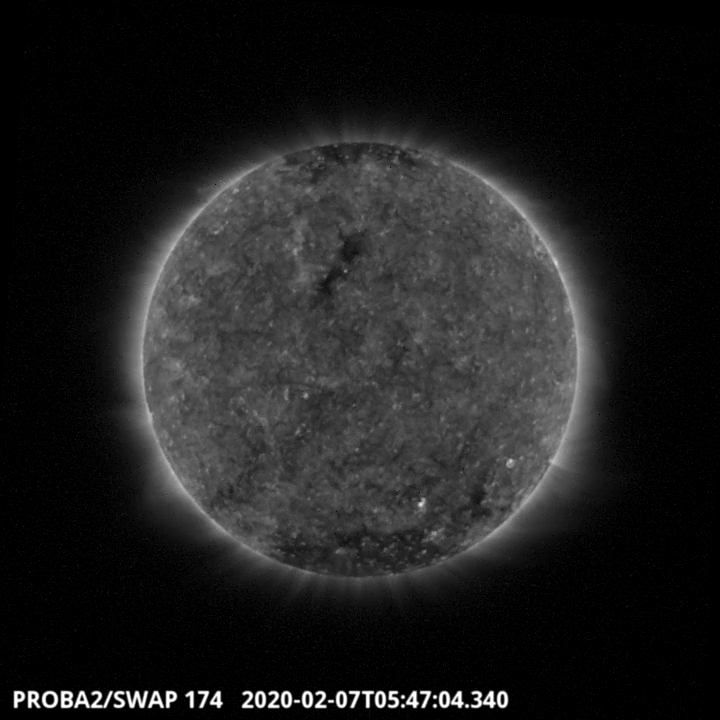
A low latitude coronal hole on the Northern hemisphere started transiting the central meridian on the morning of February 7- SWAP image. Find a movie of the events here (SWAP movie) http://proba2.oma.be/swap/data/mpg/movies/20200207_swap_movie.mp4
The International Sunspot Number by SILSO
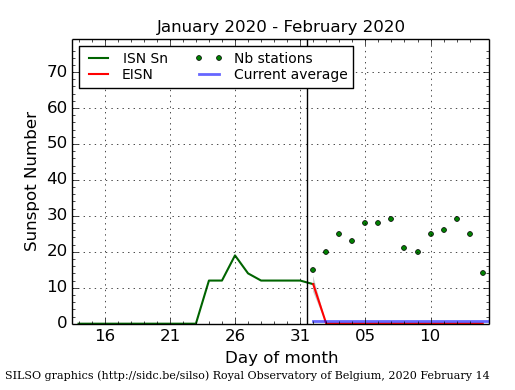
The daily Estimated International Sunspot Number (EISN, red curve with shaded error) derived by a simplified method from real-time data from the worldwide SILSO network. It extends the official Sunspot Number from the full processing of the preceding month (green line). The plot shows the last 30 days (about one solar rotation). The horizontal blue line shows the current monthly average, while the green dots give the number of stations included in the calculation of the EISN for each day.
Review of geomagnetic activity (3 Feb 2020 - 9 Feb 2020)
The solar wind was dominated by the high speed stream from the extension of the Southern polar coronal hole. February 6, the interplanetary magnetic field near the L1 point was elevated reaching peaks of 11nT. The solar wind speed steadily grew from under 400 km/s to well above 600 km/s. A peak of 680 km/s was reached in the morning of February 7 followed by a slow decline. The magnetic field Bz component was fluctuating and reached downward peaks of -10nT. The phi angle was predominantly in the negative sector throughout the week.
The geomagnetic field was active (NOAA Kp 4) due to the high speed stream with locally in Dourbes, a minor geomagnetic storm episode (local K Dourbes 5) during the onset late February 6.
The SIDC space weather Briefing
The Space Weather Briefing presented by the forecaster on duty from February 3 to 9. It reflects in images and graphs what is written in the Solar and Geomagnetic Activity report.
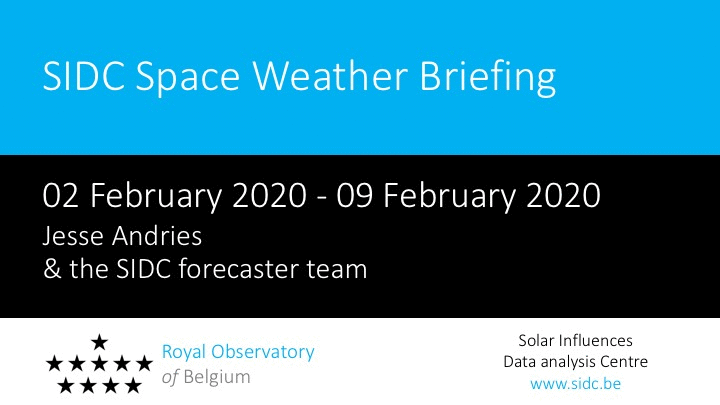
The pdf-version: http://www.stce.be/briefings/20200210_SWbriefing.pdf
The automatically running presentation: http://www.stce.be/briefings/20200203_SWbriefing.ppsm
Review of ionospheric activity (3 Feb 2020 - 9 Feb 2020)
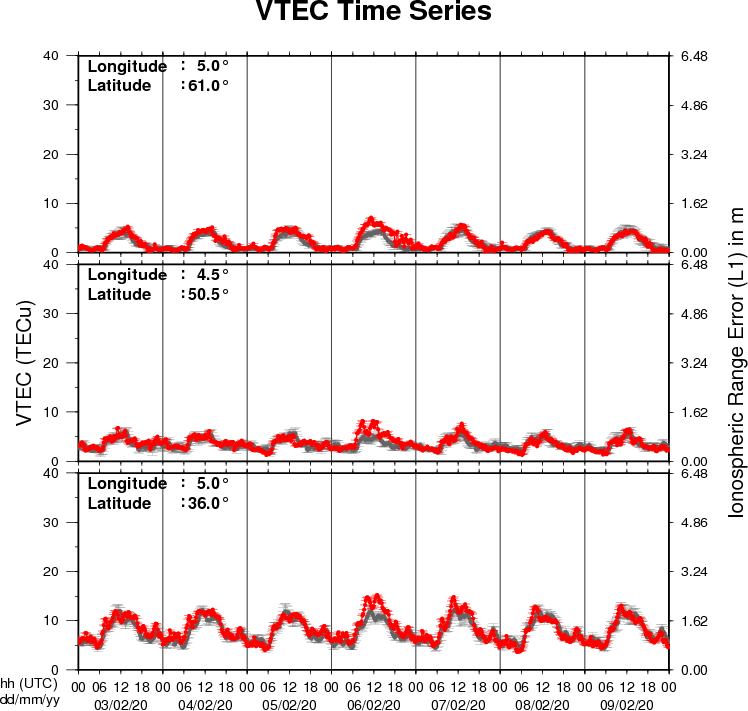
The figure shows the time evolution of the Vertical Total Electron Content (VTEC) (in red) during the last week at three locations:
a) in the northern part of Europe(N61°, 5°E)
b) above Brussels(N50.5°, 4.5°E)
c) in the southern part of Europe(N36°, 5°E)
This figure also shows (in grey) the normal ionospheric behaviour expected based on the median VTEC from the 15 previous days.
The VTEC is expressed in TECu (with TECu=10^16 electrons per square meter) and is directly related to the signal propagation delay due to the ionosphere (in figure: delay on GPS L1 frequency).
The Sun's radiation ionizes the Earth's upper atmosphere, the ionosphere, located from about 60km to 1000km above the Earth's surface.The ionization process in the ionosphere produces ions and free electrons. These electrons perturb the propagation of the GNSS (Global Navigation Satellite System) signals by inducing a so-called ionospheric delay.
See http://stce.be/newsletter/GNSS_final.pdf for some more explanations ; for detailed information, see http://gnss.be/ionosphere_tutorial.php
